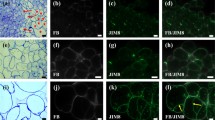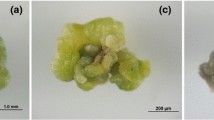Abstract
It has been established that dimedone in solid culture medium influencedthe growth of Datura innoxia Mill. callus tissues and theapoptotic processes of cells. This formaldehyde (HCHO) capture reagent appearsto modify the metabolism of plant cells, resulting in quantitative changes inthe apoptotic index (Ai). Apoptotic cells were detected insix-week-old callus tissues by the TUNEL reaction. The amount of TUNEL positivenuclei showed a characteristic spatial distribution. Enhanced DNA fragmentationwas observed in the cell layers close to the surface of the cultures. ElevatedAi was determined in cultures grown in the dark compared to thetissues grown in the light. High doses of dimedone considerably decreasedapoptosis in tissue cultures under both light and dark conditions.
Similar content being viewed by others
References
Albert L., Németh Z.S., Barna T., Varga S.Z. and Tyihák E. 1998. Measurement of endogenous formaldehyde in early developmental stages of European turkey oak (Quercus cerris L.). Phytochem. Anal. 9: 1–5.
Beers E.P. 1997. Programmed cell death during plant growth and development. Cell Death Differ. 4: 649–661.
Boor P.J., Trent M.B., Lyes G.A., Tao M. and Ansari G.A.S. 1998. Methylamine metabolism to forrnaldehyde by vascular semicarbaside-sensitive amine oxidase. Toxicology. 73: 251–258.
Burgyán J., Szarvas T. and Tyihák E. 1982. Increased Formaldehyde Production from L-methionine-(S-14CH3) by Crude Enzyme of TMV-Infected Tobacco Leaves. Acta Phytopathol. Acad. Sci. Hung. 17: 11–15.
Chelvarajan R.L., Fannin F.F. and Bush L.P. 1993. Study of nicotine demethylation in Nicotiana otophora. J. Agric. Food Chem. 41: 858–862.
Cohen G.M., Sun X., Fearnhead H., MacFarlane M., Brown D.G., Snowden R.T. et al. 1994. Formation of large molecular weight fragments of DNA is a key committed step of apoptosis in thymocytes. J. Immunol. 153: 507–516.
Gilchrist D.G. 1998. Programmed cell death in plant disease: The purpose and promise of cellular suicide. Annu. Rev. Phytopathol. 36: 393–414.
Greenberg J.T., Guo A., Kiessig D.F. and Ausubel F.M. 1994. Programmed Cell Death in Plants: A Pathogen-Triggered Response Activated Coordinately with Multiple Defense Functions. Cell. 77: 551–563.
Heath M.C. 1998. Apoptosis, programmed cell death and the hypersensitive response. Eur. J. Plant Pathol. 104: 117–124.
Heck H.A., Casanova M. and Starr T.B. 1990. Formaldehyde toxicity - new understanding. Toxicology. 20: 397–426.
Huszti T. and Tyihák E. 1986. Formation of formaldehyde from S-adenosyl-L-[methyl3-H]methionine during ernmnic transmethylation of histamine. FEBS Letters. 209: 362–366.
Hutcheson S.W. 1998. Current concepts of active defense in plants. Annu. Rev. Phytopathol. 36: 59–90.
Katsuhara M. and Kawasaki T. 1996. Salt stress induced nuclear and DNA degradation in meristematic cells of barley roots. Plant Cell Physiol. 37: 169–173.
Kedderis G.L. and Hollenberg P.F. 1983. Peroxydase-catalysed Ndemethylation reactions. J. Biol. Chem. 259: 663–668.
László I., Szőke É., Németh Z.S. and Albert L. 1998a. Plant tissue culture as a model for study of diversity in formaldehyde binding. Acta Biol. Hung. 49: 247–252.
László I., Szőke É. and Tyihák E. 1998b. Relationship between abiotic stress and formaldehyde concentration in tissue culture of Datura innoxia Mill. Plant Growth Regul. l25: 195–199.
Máday E., Tyihák E. and Szőke É. 2000. Occurrence of formaldehyde in intact plants, micropropagated plants and hairy root cultures of chamomile (Matricaria recutita L.). Plant Growth Regul. 30: 105–110.
Merk O. and Speit G. 1998. Significance of formaldehyde-induced DNA-protein crosslinks for mutagenesis. Environ. Mol. Mutagen. 32: 260–268.
Mittler R. and Lam E. 1998. Identification, characterization, and purification of a tobacco endonuclease activity induced upon hypersensitive response cell death. Plant Cell. 7: 1951–1962.
Murashige T. and Skoog F. 1962. A revised medium for rapid growth and bio-assays with tobacco tissue culture. Physiol. Plant. 15: 473–497.
Orzaez D. and Garnell A. 1997. DNA fragmentation is regulated by ethylene during carpel senescence in Pisum sativum.. Plant J. 11: 137–144.
Rajotte D., Haddad P., Haman A., Cragoe E.J. and Hoang T. 1992. Role of protein kinase C and the Na+/H+ antiporter in suppression of apoptosis by granulocyte macrophage colony-stimulating factor and interleukin-3. J. Biol. Chem. 267: 9980–9987.
Rebollo A., Gómez J., Martínez de Aragón A., Lastres P., Silva A. and Pérez-Sala D. 1985. Apoptosis induced by IL-2 withdrawal is associated with an intracellular acidification. Exp. Cell Res. 18: 581–585.
Sárdi É and Tyihák E. 1994. Simple determination of formaldehyde in dimedone adduct form in biological samples by high performance liquid chromatography. Biomed. Chrom. 8: 313–314.
Szende B., Tyihák E., Szókán G.y. and Kátay G.y. 1995. Possible role of formaldehyde in the apoptotic and mitotic effect of 1-methyl-ascorbigen. Pathol. Oncol. Res. 1: 38–42.
Szende B., Tyihák E., Trézl L., Szőke É., László I., Kàtay G.y. et al. 1998. Formaldehyde generators and capturers as influencing factors of mitotic and apoptotic processes. Acta Biol. Hung. 49: 323–330.
Tamagnone L., Merida A., Stacey N., Plaskitt K., Parr A., Chang C.F. et al. 1998. Inhibition of phenolic acid metabolism results in precocious cell death and altered cell morphology in leaves of transgenic tobacco plants. Plant Cell. 10: 1801–1816.
Taylor C.B. 1998. Defense responses in plants and animals - More of the same. Plant Cell. 10: 873–876.
Tyihák E., Rozsnyai S., Sárdi É., Gullner G., TrézI L. and Gáborjányi R. 1994. Possibility of formation of excited formaldehyde and singlet oxygen in biotic and abiotic stress situations. Acta. Biol. Hung. 45: 3–10.
Tyihák E., Blunden G., Yang M.H., Crabb T.A. and Sárdi É. 1996. Formaldehyde, as its dimedone adduct, from Ascophyllum nodosum. J. Appl. Phycol. 8: 211–215.
Tyihák E. and Szőke É. 1996. Measurement of formaldehyde and some flilly N-methylated substances in cultures of Datura innoxia.. Plant Growth Regul. 20: 317–320.
Tyihák E., Trézl L. and Szende B. 1998. Formaldehyde cycle and the phases of stress syndrome. Ann. NY Acad. Sci. 851: 259–270.
Wang H., Li J., Bostock R.M. and Gilchrist D.G. 1996a. Apoptosis: A functional paradigm for programmed plant cell death induced by a host-selective phytotoxin and invoked during development. Plant Cell. 8: 375–391.
Wang M., Oppedijk B.J., Lu X., Van Duijn B. and Schilperoort R.A. 1996b. Apoptosis in barley aleurone during germination and its inhibition by abscisic acid. Plant Mol. Biol. 32: 1125–1134.
Author information
Authors and Affiliations
Rights and permissions
About this article
Cite this article
László, I., Szőke, É., Tyihák, E. et al. Programmed cell death in Datura innoxia Mill. callus cultures cultivated in light and in dark. Plant Growth Regulation 33, 231–236 (2001). https://doi.org/10.1023/A:1017552513002
Issue Date:
DOI: https://doi.org/10.1023/A:1017552513002




